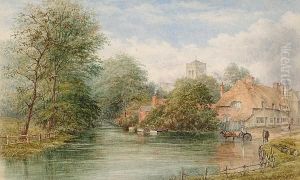William Jay Bolton Paintings
William Jay Bolton was an English artist, primarily known for his pioneering work in stained glass in the United States. Born in 1816 in the bustling city of Liverpool, England, Bolton was part of a family deeply involved in religious and artistic pursuits. His father, Robert Bolton, was a significant influence, instilling in him a love for art and the Anglican faith, which would later play a crucial role in his artistic endeavors. Despite the lack of formal training in stained glass production, Bolton's innate talent and innovative spirit led him to become one of the early masters of the craft in the United States.
In the early 1840s, responding to his father's call to contribute to the beautification of a new church in Pelham, New York, Bolton, along with his brother John, moved to the United States. There, they embarked on creating the first figural stained glass windows made in the country for the Church of the Holy Trinity in Brooklyn, completed in 1843. This monumental work not only marked a significant achievement in American art but also established Bolton as a leading figure in the nascent American stained glass movement.
Throughout the 1840s and 1850s, Bolton continued to innovate, exploring the interplay of light, color, and religious iconography in his windows. His works, characterized by their vibrant colors and intricate designs, were sought after by numerous churches and institutions, helping to popularize stained glass as a significant element of ecclesiastical decoration in America.
Despite his success, Bolton returned to England in the late 1850s, where he continued his work in stained glass and also pursued painting. His later years were marked by a shift towards painting, through which he explored various religious and historical themes. William Jay Bolton's contributions to the art of stained glass, particularly in the United States, left a lasting legacy that influenced generations of artists. He passed away in 1884, leaving behind a body of work that continues to be celebrated for its beauty and groundbreaking nature.
